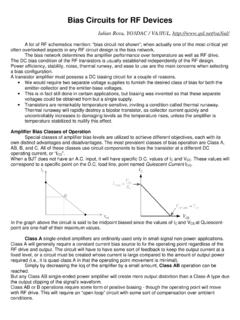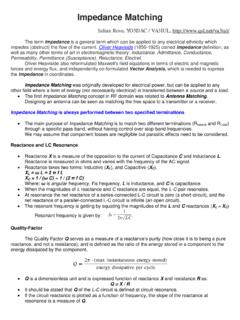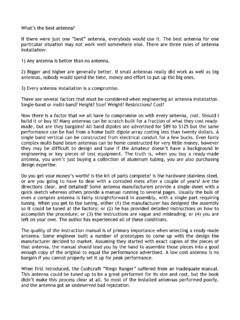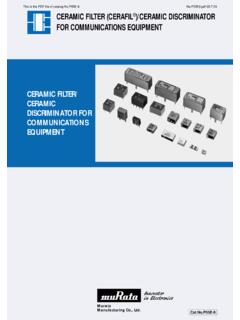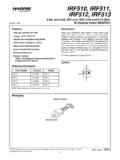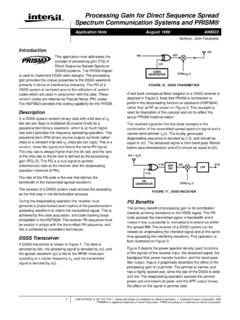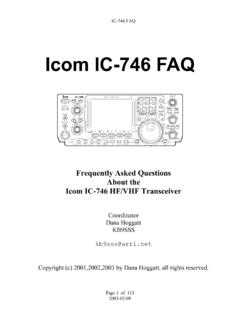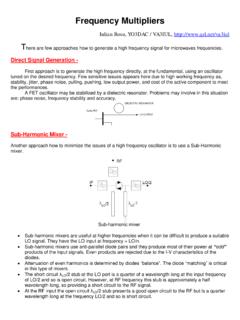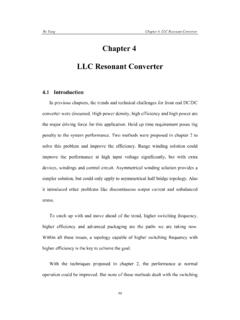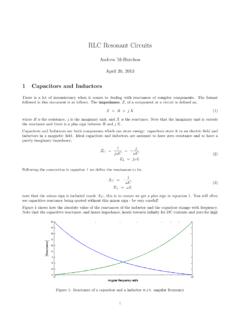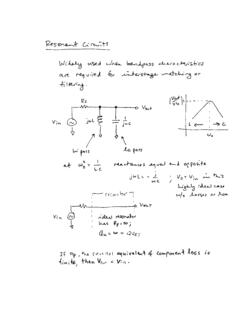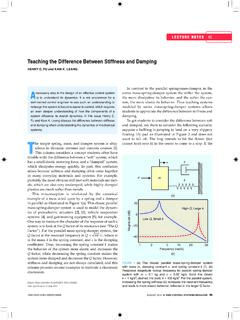Transcription of My Top Five Backyard Multi-Band Wire HF Antennas - …
1 My Top five Backyard Multi-Band wire HF Antennas L. B. Cebik, W4 RNL. 1434 High Mesa Drive Knoxville, TN 37938-4443. e-mail: 2004 marks my fifth full decade as a licensed radio amateur. So my offering to FDIM 9 will also be a matter of 5: my personal selection of the top 5 HF wire Antennas for the Backyard and for Multi-Band operation. Being a personal selection, there is no reason why your list should not be different from mine. But, along the way, I shall explain why I selected the 5 antenna types that I am including, giving you my views on both their advantages and their limitations. My list is simple and in no particular order. 1. The broadside doublet(s). 2. The dipole-doublet(s). 3. Fanned dipoles 4. The hohpl--horizontally oriented and polarized loop 5. The inverted-L. In order to make sense of what we say about each type of antenna , we need a point of reference. Since virtually all of the Antennas will be horizontal, the logical baseline to use for comparisons is the resonant 1/2-wavelength dipole.
2 So let's review its characteristics. The 1/2-Wavelength Center-Fed resonant Dipole The antenna that we loosely call the dipole is actually a 1/2-wavelength center-fed resonant or nearly resonant dipole. We usually construct it from AWG #14 or #12 copper or copperweld wire for the lower HF bands, and we may use bare or insulated wire . Often, we mislabel Multi-Band doublets as dipoles because the antenna is about 1/2-wavelength at the lowest frequency of operation. But to be strictly correct, that antenna is a dipole only at the lowest frequency of use. Fig. 1 shows the two essential dimensions of a real dipole. Since we tend to feed the dipole with coaxial cable, we are concerned with the antenna length and resonance. In other words, we want a good match between the coax and the antenna feedpoint. However, we also need to be equally if not more concerned with the antenna 's height above ground. The old adage, "The higher, the better," arose from the use of wire Antennas on the lower HF bands, where we generally could not achieve even a height of 1 wavelength.
3 Table 1. Approximate Lengths of a Wave in Feet band Frequency Length band Frequency Length meters MHz feet meters MHz feet 160 546 20 70. 80 273 17 54. 75 252 15 47. 60 183 12 40 10 28 35. 30 Table 1 serves as a reminder of how long a wavelength is on each of the HF amateur bands. For most Backyard Antennas , the average ham is lucky to achieve an antenna height of 1 wavelength on 10. meters, while the truly fortunate operator may get his wire to 1 wavelength on 17 or 20 meters. Every horizontal antenna is subject to essentially the same general phenomena that affect horizontal dipoles in terms of their height above ground. The lower the antenna as a fraction of a wavelength, the lower will be the overall gain and the higher the elevation angle of the radiation. Fig. 2. illustrates the principle for a dipole placed at 1/4, 3/8, 1/2, and 1 wavelength above average ground. Unlike vertical monopoles, horizontal wires do not change their gain or elevation angle significantly with changes in soil quality.
4 The elevation plots on the right show that the lower we place a dipole, the higher the angle of radiation, a fact that limits our effective range of communications under normal propagation conditions. The azimuth patterns on the left not only show the reduction of gain with a reduction in height, but as well the change in pattern shape. As we reduce the height of a dipole, its figure-8 shape at 1-wavelength devolves into a simple oval at a height of 1/4-wavelength. What applies to the dipole will generally (but not without some exceptions) apply to any horizontal wire antenna relative to its height above ground at the frequency of operation. When it comes to height, think wavelengths, not feet! 1/2-wavelength resonant center-fed dipoles have many other interesting characteristics, but the ones that we have noted will guide us while we explore the top 5 Multi-Band Backyard wire Antennas . We shall also be setting aside our coaxial cable in favor of parallel feedline to an antenna tuner (ATU) or, as some British writers prefer, an antenna system tuning unit (ASTU).
5 Consider the ATU to be a lifetime investment. 1. The Broadside Doublet(s): The broadside doublet is a simple Multi-Band doublet with a 4:1 frequency range for the desired characteristic. Fig. 3 shows the general outline. In principle, the doublet is physically no different from a dipole. However, electrically, it is significantly different. First, we feed it with parallel transmission line to an antenna tuner, because the feedpoint impedance varies greatly as we change operating frequencies from one band to the next. Second, we select the length so that the antenna will show a bi-directional pattern broadside to the wire on all of the bands included. Note that the length makes the antenna an extended double Zepp at the highest frequency. With an antenna tuner, the antenna will operate above its highest included frequency, but the pattern will break up into multiple lobes. Table 2 provides the most convenient lengths and the bands included. Table 2. Broadside Doublet Lengths and Amateur band Coverage Length (feet) Bands covered 44' 10, 12, 15, 17, 20, 30, 40 meters 66' 15, 17, 20, 30, 40, 60 meters 88' 20, 30, 40, 60, 80 meters The chief advantage of the broadside doublet is that you always know the directions of your radiation or your most sensitive reception.
6 A second advantage is the antenna 's simplicity for a 4:1. frequency range with the bi-directional characteristic. A third advantage, which we shall note shortly, is the flexibility of the antenna in forming wire arrays having different characteristics. With every set of advantages come one or more disadvantages. First, the antenna requires a wide-range ATU, since the impedance varies greatly from band to band . Since the exact values that will appear at the tuner terminals will vary with both the antenna height and the length and characteristic impedance of the parallel transmission line, I shall not provide specific numbers. Second, the gain goes down with frequency. The broadside doublet has its highest gain at the highest frequency. The gain drops a bit with each move to a lower band , while the pattern broadens. Fig. 4 shows the patterns overlapped in free-space models. However, remember that as we go down in frequency, the antenna will have a height that is a smaller fraction of a wavelength.
7 Hence--like the dipole--we can expect a further reduction in gain and a more significant increase in the elevation angle of maximum radiation. Hence, the higher you can place the antenna , the better will be its performance. Part of the flexibility of the broadside doublet stems from the ease of covering the full horizon by adding only one more support. See Fig. 5. We can easily form a triangle of doublets. The triangle need not be perfect, so you can adjust it to aim more exactly at your favorite communications targets. With only a bit of end space (about 10% of the wire length), the inert wires will not materially affect the operation of the one in use. The only caution that you need to observe is to keep the feedline lengths identical. This caution applies whether you use a fancy switching box at the center of the array or whether you bring three separate and well-spaced lines to the shack entry point and do your switching indoors. Equal line lengths will mean that you do not have to do major retuning when switching from one antenna to the other.
8 Hence, you can easily determine the most effective antenna for an incoming signal just by switching through the 3 Antennas . Note that the triangle refers to either doublets or lazy-H Antennas . That is part of the flexibility of the broadside doublet system. We can make lazy-H arrays using any of the listed element lengths and cover the same set of bands--but with more gain. Fig. 6 the outlines of a lazy-H. The lazy-H is simply 2 broadside doublets fed in phase. We need the center main feed point to ensure that the lines to both wires are the same length and therefore give us the same current magnitude and phase angle at both element feedpoints. So PL1 and PL2 are 1/2 of PL. The total length of the phase line assembly can be longer than the spacing, but for most installations, they are the same. The ideal spacing is 1/2 of L, the element length. Hence, the spacing is 5/8-wavelength at the frequency where the element is wavelengths. This spacing provides maximum gain.
9 You can reduce the spacing somewhat, but every reduction reduces the gain on all bands. The ideal lazy-H will net you almost 3-dB gain on the highest bands. There will be a slight reduction for the lowest bands, since the spacing will no longer be optimal. As well, the lower wire gets closer to the ground as a fraction of a wavelength when we reduce the frequency. Fig. 7 shows the overlaid free-space patterns to give you a basic idea of what happens to shape and strength, but remember to modify your expectations depending upon the height that you place the antenna . Getting the lowest wire at least 1/2-wavelength above ground is best, although lower heights for that wire will work. However, if that wire will be under 1/4-wavelength above ground, you may be better off with a simple broadside doublet at the upper level. It will give you a lower radiation angle than the pair of wires. As a side note, in any set of in-phase fed Antennas --whether doublets, Yagis, or whatever--the effective height of the combination will be a point about 2/3 the distance between the lowest and the highest Antennas .
10 Of course, we can make a triangle of lazy-Hs, just as we can for the basic doublet. There is a second Multi-Band array that we can make from the broadside doublet: an 8JK. See Fig. 8 for the outline. Developed by John Kraus, W8JK, in the 1930s, the antenna has undergone many variations. The versions shown here is designed for a 3:1 frequency range. It uses the broadside doublet lengths for the highest frequency, along with a total phase-line length that is 1/2 of the element length, L. However, note that when we create this end-fire array, we give one (and only one) of the phase line sections a half twist. The specific dimensions we have chosen from W8JK's work are ones that give us an interesting pattern of gain, as shown in the free-space patterns of Fig. 9. The free-space gains are about equal on all bands. Indeed, the only factor that limits our frequency coverage is a very low impedance below the listed frequency limit. Of course, over ground, the gain will decrease as we lower the frequency, since the array will be lower as a fraction of a wavelength.
